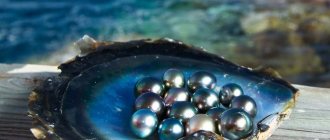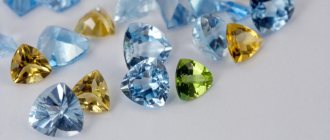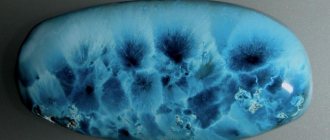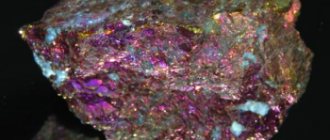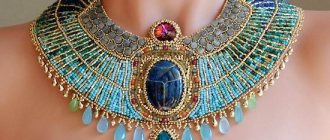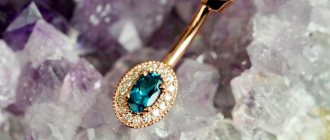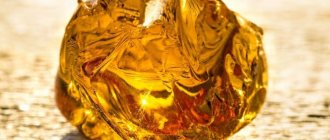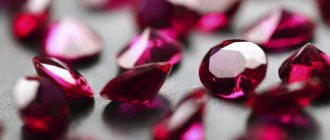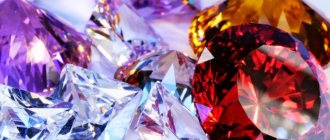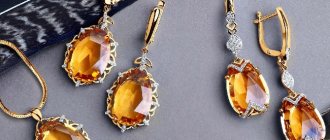What is glass ceramic
Sitall is a glass crystalline material. It was synthesized in laboratory conditions and its composition replicates aluminosilicate glass. Its natural analogue is obsidian volcanic glass.
A modern modification is nanoalloy. Consists of SiO2 and Al2O3 - the basic components of most natural jewelry stones.
Faceted stones
The technology allows you to create stones of any transparency, color, size or purpose. Based on these characteristics, the classification distinguishes jewelry material, ceramics and slag ceramics.
| Density | 2400-2950 kg/cub.m |
| Flexural strength | 70-350 MPa |
| Temporary resistance | 112-161 MPa |
| Water absorption | 0.01% |
| Electric strength | 25-75 MV/m |
| Heat resistance | up to 1000 °C |
| Mohs hardness | 6.5-7 units |
| Special properties | transparent, magnetic, semiconductor, radiotransparent |
History of the stone
Sitall is a product whose creation history is ambiguous.
Russia and the USA dispute the right to be considered the “parent” of the stone:
- American Donald Stuckey developed the technology in 1957. The company that created the crystals called the material pyroceram.
- In the Soviet Union, the development of glass ceramics was carried out by a group of scientists led by Isaac Ilyich Kitaigorodsky. He came up with the idea of using metallurgical waste (blast furnace slag) as a raw material for stone production.
He also introduced the concept of “ceramic glass” into scientific use. According to one version, it is a hybrid of “glass” and “crystal”. According to another, the term is derived from the names of the chemical elements that form the crystal: sicilium (silicon) and aluminum.
Rules of care
The rules for caring for ametrine are the same as for other ornamental stones:
- do not use active detergents;
- When cleaning, use a weak soap solution;
- after cleaning, rinse in warm running water and wipe dry;
- do not leave in the sun;
- store in a dark place (preferably in a specially designated box with soft walls).
The amazing beauty of ametrine continues to captivate jewelry lovers. People are especially attracted to the magical qualities and romantic stories associated with the mineral. The cost on the market is usually low, so anyone can become the owner of such jewelry.
Properties of the stone
Sitall is glass-like crystals. But their properties are radically different from “glass”.
Characteristics of the stone:
- hardness on the Mohs scale – 6.5–7;
- density – 2.4-2.9 g/cm3;
- melts at 1000 °C; in some types of crystals it is higher.
Other qualities of the stone are provided by the chemical composition and structure:
- Heat resistance is guaranteed by lithium, aluminum plus mineral raw materials (mullite, eucryptite, spinel) in the crystals.
- Unlike natural stones, glass ceramic has zero porosity.
- The ultra-fine grain makes it an electrical insulator.
- Increased density creates the same thermal conductivity.
- The stone is chemical resistant.
The transparency of the crystals is almost perfect: their length is measured in hundredths of a millimeter, which is half the wavelength perceived by the human eye. Jewelers appreciate this.
Properties of industrial glass ceramics (to enlarge, click on the picture)
How to get crystals
The manufacturing technology of glass ceramics is almost the same as that of glass or glass ceramics. The property of glass to crystallize is taken as a basis.
Stages of stone production:
- A “source” is prepared—a charge consisting of one or more nucleators (nucleus-forming substances-clarifiers). They determine the number of central elements for further crystallization. For every mm3 there are billions of such substances.
- The charge melts. This process is two-phase. First, the centers of the crystal crystallize, then the temperature is increased so that they are overgrown with new aggregates.
- The molten mass is poured into molds.
- The resulting stone is cooled.
The result is fine-crystalline glass ceramics.
Unlike the production of glass through spontaneous crystallization, with glass ceramics everything is ordered and controlled.
Sitall production technology was used to mold ruby sital glass for the stars on the Spasskaya Tower of the Moscow Kremlin.
Medicinal use
Ametrine stone has long been appreciated by lithotherapists. They recommend use for a number of diseases and conditions:
- nervous disorders;
- chronic fatigue;
- depression and insomnia;
- anxiety disorders;
- problems with the intestines and stomach;
- inflammatory processes of various origins;
- kidney and bladder diseases;
- migraines and other headaches.
An ametrine bracelet will help improve the condition of skin diseases. The earrings cleanse the blood and improve cerebral circulation, and the ring with the gem increases male potency.
One of the remarkable properties of ametrine is its compatibility with any medications, so it can be used in the treatment of any medications without fear of side effects.
Jewelry
Obtaining stone for jewelry became possible in the new millennium, with the advent of nanotechnology. Initially, he was supposed to copy sapphires and emeralds. However, today they create glass ceramic samples of any color with predetermined dimensions.
London glassware
Types of stone
Dozens of types of jewelry glass ceramics have been obtained. The main ones are:
- ametrine – copies a two-color rare expensive stone (a mixture of amethyst and citrine);
- Madeira citrine;
- tourmaline – the Paraiba variety is especially good;
- tanzanite;
- garnet trillion;
- London glassware;
- sultanite
Nanosynthetics imitate any natural stones, but they are cleaner and more transparent than natural ones.
Product range
The strength of nano-alloys is such that jewelers create a full range of jewelry - from pendants to massive necklaces:
- The stones are framed in silver or gold and combined with white or colored cubic zirconia.
- The style of the products allows you to choose jewelry with glass ceramics for all occasions: for the office, for a walk or for a prestigious reception.
- For daytime outings, a palette that imitates opaque stones is appropriate: opal, cacholong, agate, turquoise, and others.
Sitall in jewelry
Sitalls are super strong. Some caution will be required if combined in a product with cubic zirconia. The latter are more vulnerable.
Price
The synthesized material is financially accessible to everyone. The cost of the jewelry is determined more by the material of the frame.
Prices of Russian manufacturers (thousand rubles):
- silver earrings with sitall – 2.3–4.5;
- silver ring – 3.4–6.7;
- gold earrings – 34–45;
- gold ring – 31–48.
The terms “ceramic glass” and “nano metal” are equivalent in the jewelry industry. Both options are used on the tags or in the description.
At the same time, the most expensive ones are red “ruby” crystals. Next come blue, blue glass-ceramic (imitating aquamarine), and lilac stones. However, the difference in the price of inserts does not exceed a couple of tens of percent.
Colors and varieties
The unique technology for creating new generation nanocrystals allows you to obtain completely different shades. The sizes of stones and shapes can be absolutely any. The degree of transparency of artificially produced nuggets can also be absolutely any.
Based on this, the following varieties of glass ceramics are obtained:
- jewelry;
- ceramic;
- slag ceramics.
The product differs in properties, features of use, accordingly, cost and demand. By setting the desired color parameters, scientists produce the following properties:
- London Sitall;
- Madeira citrine;
- garnet trillion;
- paraiba tourmaline;
- ametrine;
- tanzanite;
- sultanite
Any jewelry nanocrystal will be many times purer and more transparent than a natural sample.
Other uses
Citaals are not only an affordable analogue to precious jewelry raw materials. Artificial stone is used in practical, “mundane” areas:
- Mechanical engineering . The properties of glass ceramics are regulated by supplementing the composition with the necessary elements. For example, raw materials modified with perlite or dolomite become a reliable electrical insulator. Copper or silver increases sensitivity to photochemical processes. Sitall coating of metal parts makes them beautiful and invulnerable to corrosion.
- Optics . Raw materials with additives are quite transparent, so they are used in the manufacture of mirrors, lenses, light filters and a similar range.
- Oil Gas . Sitall pipes are ordered by companies for the extraction, processing, and transportation of raw materials. They have increased thermal and mechanical wear resistance. The material is durable and reliable, which is important in the harsh climate of Siberia or the Far North, when delivering raw materials over a thousand kilometers.
- Electronics . In radio electronics, crystals are used as dielectric insulation of microcircuits.
- Aviation . Glass ceramics based on them are a material for rocket fairings.
- Construction . A popular material for new generation floors is glass marble. Its consumer characteristics are beyond praise: unpretentious, does not wear out for decades.
- Medicine . In dentistry, crystals have found application as a material for fillings and dentures.
- Household sphere . Ceramic glassware and other containers are even suitable for microwave ovens.
Citall blanks
In these areas, various grades of ceramic or slag ceramic are used: lithium, boron-barium, magnesium, titanium, and others. A new trend is slag foam.
In the Ostankino Tower, the floor is made of this transparent glass-crystalline material, which is not inferior in strength to metal, and is built into separate elements into a regular floor. Each of these blocks is designed to support a weight of up to 10 tons.
Glass floor in the Ostankino tower
Legend
There is only one deposit on Earth where this stone is still mined. It is located in Bolivia and is called Anajai. That was the name of the daughter of the leader of a Bolivian tribe. In the 16th century, Spanish conquistadors arrived in Bolivia with the goal of conquering this country. Among them was Felipe Urriola, who fell in love with Anajai and wanted to marry her. Despite the fact that the girl's father and her fellow tribesmen were against it, the couple got married. This became the reason for new hostility and persecution.
When Felipe realized that he would not be able to reconcile with his beloved’s tribe, he invited her to escape to his homeland, Spain. But although the girl loved the conquistador, she refused, deciding to stay in her native tribe forever. However, her fellow tribesmen did not appreciate her action and decided to kill her. As a result, Anakhai was mortally wounded, but before her death she managed to give her lover a beautiful two-color stone, symbolizing the fidelity of her heart and the inviolability of the union of two loving people.
After returning home, Felipe appeared before the Spanish queen and showed her the gem. The queen liked the nugget, and she bought it from the conquistador. From then on, she began to wear it every day, and this was the beginning of the popularity of ametrine (and by tradition is sometimes still called bolivianite).
Until the beginning of the 20th century, ametrine did not become widespread outside of Bolivia and Spain. Export to other countries was practiced exclusively through smuggling. The beginning of legal supplies dates back to the end of the 80s of the last century - after the worldwide presentation at one of the famous exhibitions.
Advantages of synthetic stone
The advantages of synthetic crystals in industry or other sectors are not in dispute.
Their use has sparked controversy in the beauty industry. But here, too, the glass ceramic stone has many fans.
Jewelry with Sitall
The advantages of laboratory-created crystals are obvious:
- Outwardly indistinguishable from natural ones, they look natural, expensive, and chic.
- In terms of physical parameters - purity, resistance to external influences, etc. - they are superior to natural ones.
- Sitall products do not require special care or caution when using. Can last forever.
- They cost tens to hundreds of times lower than their natural counterparts.
Typical examples:
- Morganite . This pink beryl in its natural form is often cloudy and discolored even in the sun. Due to the presence of radiation, large products are not made from it. At the same time, the cost is prohibitive. Sitall glassite is transparent and indifferent to temperature. There is no talk about radiation. A beautiful peach nanocrystal with a slight haze is transformed into a cushion.
- Paraiba tourmaline . Natural stone is very rare, expensive, but almost always far from ideal. Paraiba sitalla has a bright, thick turquoise and blue color. Extraordinary color iridescence appears even at dusk. This quality gave rise to the names of the crystal - electric or neon.
- Seatall London . Copy of smoky blue-gray topaz. But it does not turn pale or become chaotically spotted in the sun.
- Sultanite . This sital crystal has a more distinct color iridescence than a natural one. Not afraid of the sun.
Citales in jewelry are spectacular with white or rose gold. They look expensive, so jewelry with them is worn with luxury clothing.
Citales are superior in physical and aesthetic parameters to cubic zirconia, Swarovski crystals, and other “old” artificial analogues. They are more durable and do not fade. After cutting or other processing, even large crystals retain their shine and color.
Is it possible to distinguish a fake?
The question is what is fake and what is not. If the seller honestly tells you that he is offering you heated quartz or glass ceramic, there is no talk of counterfeiting or deception. Moreover, such options look attractive, and when they are sold at the right price, why not take advantage of the advantageous offer? On the other hand, many people dream of natural samples, but their cost will be much more expensive.
Cheap glass or plastic is often used as a counterfeit. A characteristic feature of both substances is rapid heating in the palm. Natural stones are usually cold and heat up slowly. Also, natural or laboratory samples are much heavier than plastic or glass. They are quickly damaged when touched with a sharp object. Of course, you are unlikely to be allowed to conduct such experiments, but it also doesn’t hurt to take this fact into account.
Remember that bright colors can indicate both counterfeit and processing. Unfortunately, it is not always possible to conduct a detailed gemological examination, so the risk of counterfeits being sold on the market is still very high.
Magical or not?
Sitalls are grown by humans, so they have no healing or magical properties.
But there are advantages to this. Intrigues or “whims” on the part of the stone are excluded. The most powerful sorcerers or other ill-wishers cannot charge it to the detriment of the owner.
Finally, you can choose and wear jewelry as you wish: sital suits everyone, regardless of their zodiac sign.
| Zodiac sign | Compatibility |
| Aries | + |
| Taurus | + |
| Twins | + |
| Cancer | + |
| a lion | + |
| Virgo | + |
| Scales | + |
| Scorpion | + |
| Sagittarius | + |
| Capricorn | + |
| Aquarius | + |
| Fish | + |
(“+++” – fits perfectly, “+” – can be worn, “-” – is strictly contraindicated).
Talismans and amulets
Ceramic jewelry of any type or shape should never be considered as a talisman or talisman. The absence of supernatural properties of a nanocrystal simply cannot give what a person expects.
There will be no help or protection from such patrons; the stones simply cannot hear their owner, since they are “dead” and do not have a “soul”. These are just beautiful products to decorate the body - that's all!
Note! Often, charlatans promise to charge the glass-ceramic jewelry with the necessary magical energy, adjust the gem to the desired mood, and give it a certain program - nothing like this can be done with a nanoproduct, it’s all a deception.
